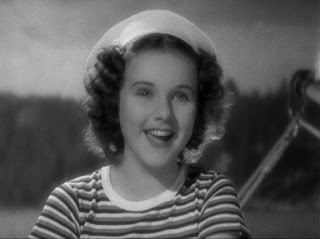The comedy-musical-romance Three Smart Girls, released in 1936, launched Deanna Durbin’s career. Since Deanna Durbin pretty much kept Universal Studios afloat for the next decade you could argue that this movie in effect saved the studio.
Durbin was just fourteen at the time she made this movie. Universal weren’t quite sure that an unknown and untried fourteen-year-old girl could carry a movie on her own so she is in fact one of the three female leads, the three smart girls of the title. Durbin immediately proved that the studio needn’t have worried. Her star quality is obvious. Star quality is of course incredibly important but if an actress has that other intangible quality, likeability, it’s even better. And Deanna Durbin had plenty of likeability.
The three smart girls are Joan (Nan Grey), Kay (Barbara Read) and Penny (Durbin). They are sisters and they live with their mother Dorothy. Ten years after her divorce Dorothy Craig still carries a torch for their father. Now the news that she has been dreading has arrived. Her ex-husband, Judson Craig (Charles Winninger), is about to remarry. He is going to marry a woman named Donna Lyons (Binnie Barnes). The three sisters decide that they must do something about this so they set off for New York to save Daddy from the clutches of the wicked adventuress Donna.
Of course Judson Craig has no wish to be saved. He’s a middle-aged man who is about to snare himself a glamorous much younger bride and that’s not something most middle-aged men want to be saved from.
As you might expect, the three girls cook up a scheme to throw a spanner into Donna’s wedding plans. At the same time Donna and her mother are scheming to get the three girls out of New York and out of their way.
The sisters have an ally in Judson Craig’s business manager Bill Evans and Evans comes up with what seems like the perfect solution - to set Donna up with a rich Hungarian, Count Arisztid (Mischa Auer). Being a gold-digger Donna is sure to chose a dashing nobleman with money over the middle-aged Judson Craig. There’s no need to tell Donna that the count is actually a penniless drunk. Complications ensue when Lord Michael Stuart (Ray Milland), who owns half of Australia, gets unwittingly mixed up in events.
This was the first of many Hollywood successes for director Henry Koster among which were quite a few more Deanna Durbin pictures including the delightful First Love.
Deanna Durbin was a very big star indeed, in fact she was at one time the highest paid star in Hollywood, but she hasn’t retained the kind of following among classic movie fans that you might expect. She’s not quite forgotten, but almost so. This may have something to do with her singing. Not that there’s anything wrong with. She was a great singer. But she was a proper soprano and her style of singing is probably a lot less accessible to modern audiences than the more familiar jazz/swing style of the 40s. It’s a pity because she really was a great star. She was a very competent actress (who could handle serious rôles on the rare occasions they were offered to her), she was very good at light comedy and she was thoroughly charming. Her performance here is just right. She’s a bit precocious, but not irritatingly so. She’s funny and she’s sweet.
Nan Grey (an underrated actress whose career was sadly short-lived) is very good as Joan. Charles Winninger is amusing as poor Judson Craig, surrounded by women whose machinations leave him perplexed. Binnie Barnes is also excellent as the scheming gold-digger Donna. Ray Milland is in splendid form as well.
We naturally get several songs from Durbin. Three Smart Girls is however mostly a comedy-romance and it is genuinely very amusing. I can’t really think of anything negative to say about this movie - it does everything it sets out to do and does so effortlessly and charmingly. It has a very strong cast, the script has all the standard complications you’d expect but it’s all very expertly executed.
This is the fourth Deanna Durbin movie I’ve seen and I’ve liked them all. I guess that makes me a confirmed Durbin fan.
Three Smart Girls is highly recommended.
























